By Hailey Simpson, Coastal Engineer
Living shorelines are starting to become the talk of the town for many coastal communities that want to increase the resiliency of their shoreline. By using a naturalistic approach, living shorelines create a more durable and sustainable coast for both people and coastal resources. The National Oceanic and Atmospheric Administration (NOAA) defines a living shoreline as a “protected, stabilized coastal edge made of natural materials such as plants, sand or rock. Unlike a concrete seawall or other hard structure, which impede the growth of plants and animals, living shorelines grow over time.” Since the living shoreline structures benefit both people and the coastal environment, federal, state and local regulatory agencies are beginning to favor these solutions above the age old “hard structures.”
While heavily promoted and generally viewed as beneficial, living shorelines cannot be constructed along every coastline. Engineers and designers must analyze individual project sites to determine the best solution that will provide optimal resiliency along with sustainability. Designs range from soft “green” solutions to slightly harder “hybrid” solutions depending on the location and wave climate of the project site.
“Green” solutions typically include only biodegradable components and vegetation. These “green” solutions, although favored by regulatory agencies, are difficult to maintain in locations with a high wave energy climate. Wetland vegetation requires approximately 24 months to develop a proper root system, which serves as the natural erosion deterrent for a living shoreline. Locations with high wave energies will not provide a “green” living shoreline solution the proper amount of time needed to establish itself and thus are not a suitable resiliency solution for these areas. Therefore, “green” solutions are primarily designed for sections of the coastline that have a low wave energy climate.
On the contrary, “hybrid” solutions consist of combining hard, natural materials, such as rock with natural “green” materials such as beach nourishment sand and tidal vegetation. Unlike “green” living shoreline solutions, “hybrid” solutions are designed for sections of the coastline with a moderate to high wave energy climate. Since it combines durable rock with natural materials, the “hybrid” solution promotes environmental sustainability while being able to dissipate high wave energy and provide greater protection during storm events.
RACE Coastal Engineering (RACE), based in Stratford, CT, has designed and is currently involved in a number of “green” and “hybrid” living shoreline solutions for residential, commercial and municipal clients. Each is tailored toward the specific characteristics of the project sites. Depending on the site, detailed wave models are performed to determine the specific wave climate in order to design a solution that best fits the environment.
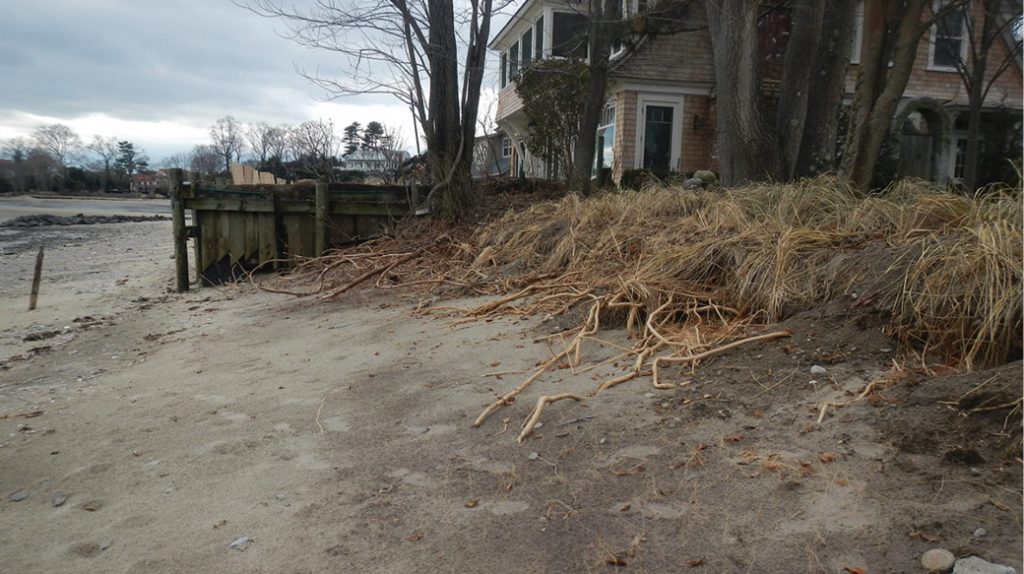
Before – Severely eroded bank
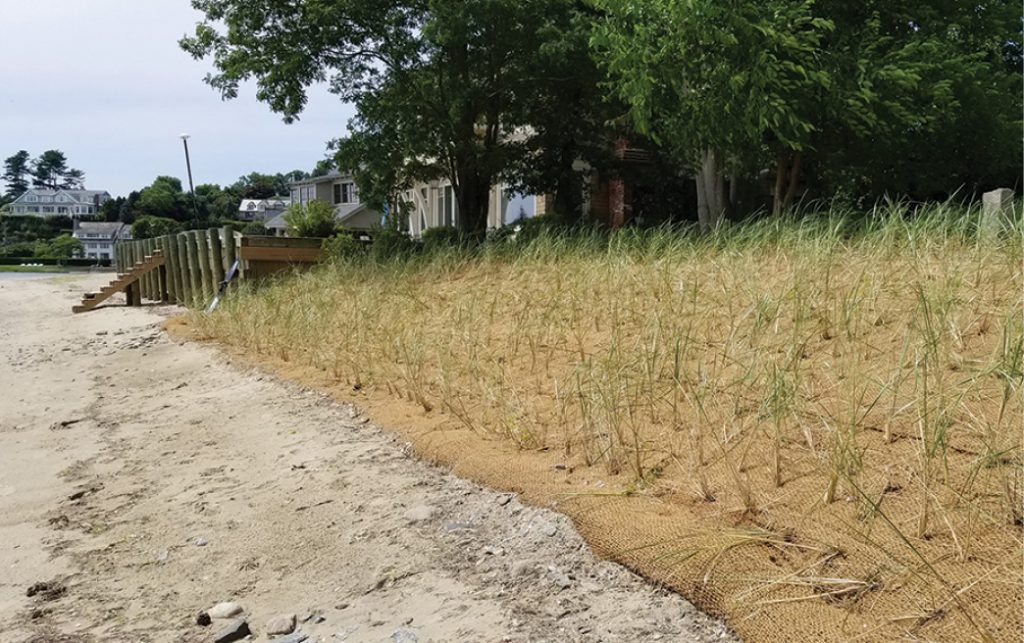
After – “Green” Living Shoreline Solution
Westport, CT – Residential – “Green” Solution
A residential property owner contacted RACE to help protect a vacant building lot located on a cove in Westport, CT. The project site had a bank which was severely eroding and threatening large established trees and their root systems with saltwater intrusion.
Since the project site was currently undeveloped without a dwelling and a “hard” structure was not currently present at the site, Connecticut State statutes would not support construction of a flood and erosion control structure. Thus, RACE developed a “green” living shoreline solution to mitigate the bank erosion. The “green” solution included a biodegradable coir log revetment adjacent to the bank to provide erosion protection for the area landward of the bank. The coir logs were anchored to the earth using duckbill anchors and wooden stakes. Beach sand with a coir mat and native wetland plantings were placed on top of the coir log revetment to provide a secondary layer of protection in the form of a dune. A coir log was placed at the toe of the dune to increase stability, and a sprinkler system was incorporated to support the plantings.
Due to the sensitivity of a “green” living shoreline solution, continued monitoring and maintenance is necessary to allow the solution to remain resilient in the face of Mother Nature. Continual replenishment of the beach nourishment sand and plantings will need to be incorporated as monitoring may suggest.
East Haven, CT – Residential – “Hybrid” Living Shoreline
On August 28, 2011, a condominium association was hit hard by Hurricane Irene and faced significant damage along its vegetated sloping bank bordering Long Island Sound. In October 2012, Superstorm Sandy was predicted to impact the site and in response, the condominium association protected their previously damaged bank with a temporary sandbag embankment. On October 28, Superstorm Sandy passed near the site and scattered the temporary sandbag embankment across the beach, further damaging the bank and condominiums.
RACE collaborated with regulatory agencies to determine the most resilient solution for the damaged bank that would ultimately protect the shoreline as well as the condominium buildings. Prior to Superstorm Sandy, regulatory agencies opposed any solution that included hardened structural elements. After Sandy, it was agreed that a structural solution at the project site was necessary and unavoidable to protect the buildings. RACE designed a “hybrid” living shoreline solution consisting of a stone revetment core topped with beach nourishment sand and native wetland vegetation to help stabilize the sand and to provide coastal wildlife with additional habitat.
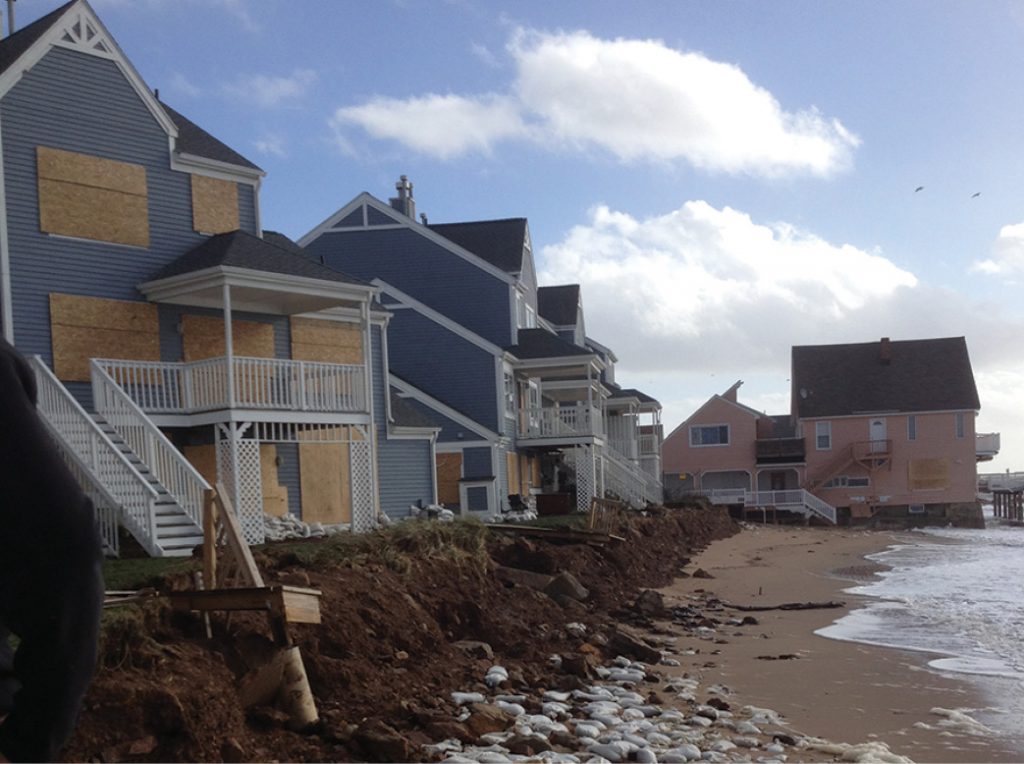
Before – Scattered Sandbag Embankment Two Days After Superstorm Sandy
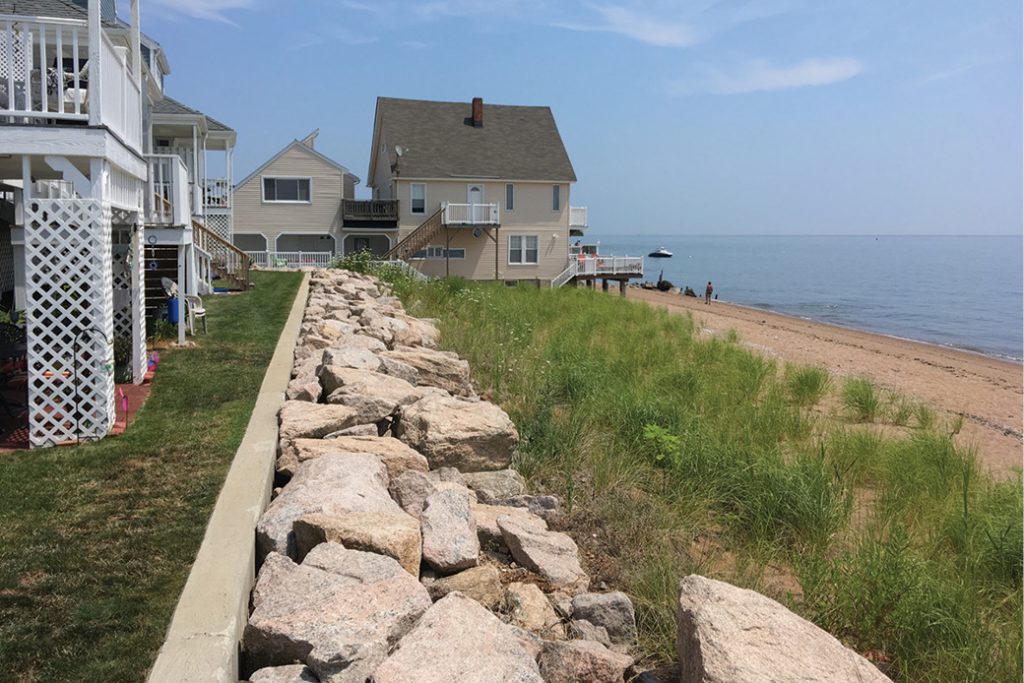
After – “Hybrid” Living Shoreline Solution
Construction of the “hybrid” living shoreline solution at the condominium complex was completed in 2014 and is still thriving today. Since living shoreline solutions are still a new approach to addressing resiliency and sustainability, their design and construction requires strong coordination between a variety of stakeholders, as well as monitoring and adaptive maintenance, in order to be successful.
Canal Road – Residential – “Hybrid” Living Shoreline
Over time, much the Connecticut coastline has been transformed from marsh wetlands to structural developments that included the construction of shoreline flood and erosion control structures. These structures cut off the daily tide cycle and impact the wetland functions. The Canal Road area in Westport is one such example where residential development and hard shoreline structures have been placed alongside a marsh environment.
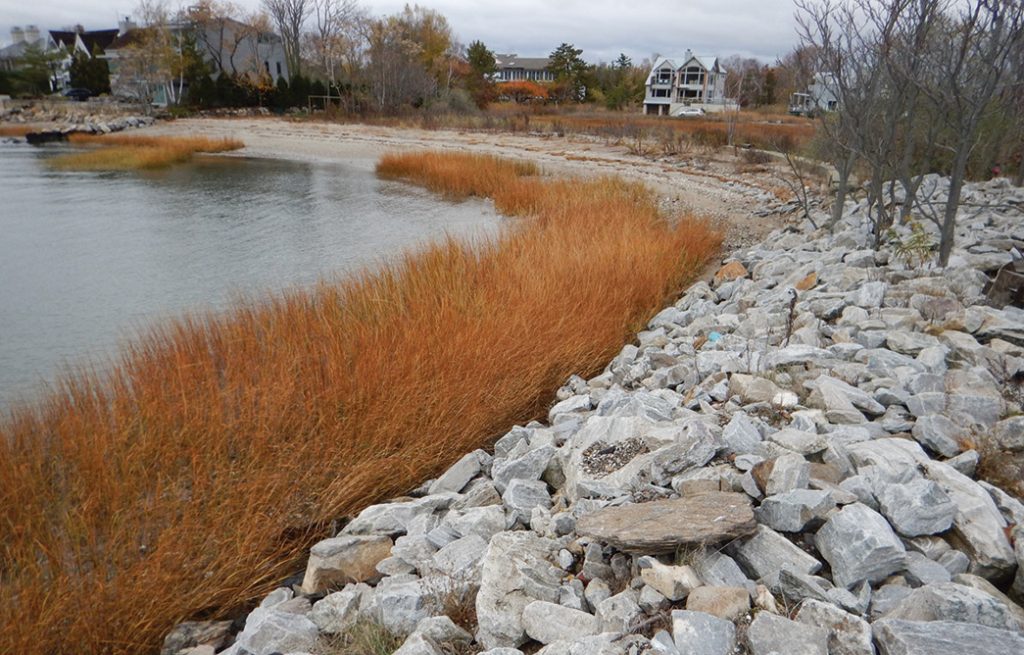
Before – Marsh Vegetation located on Both
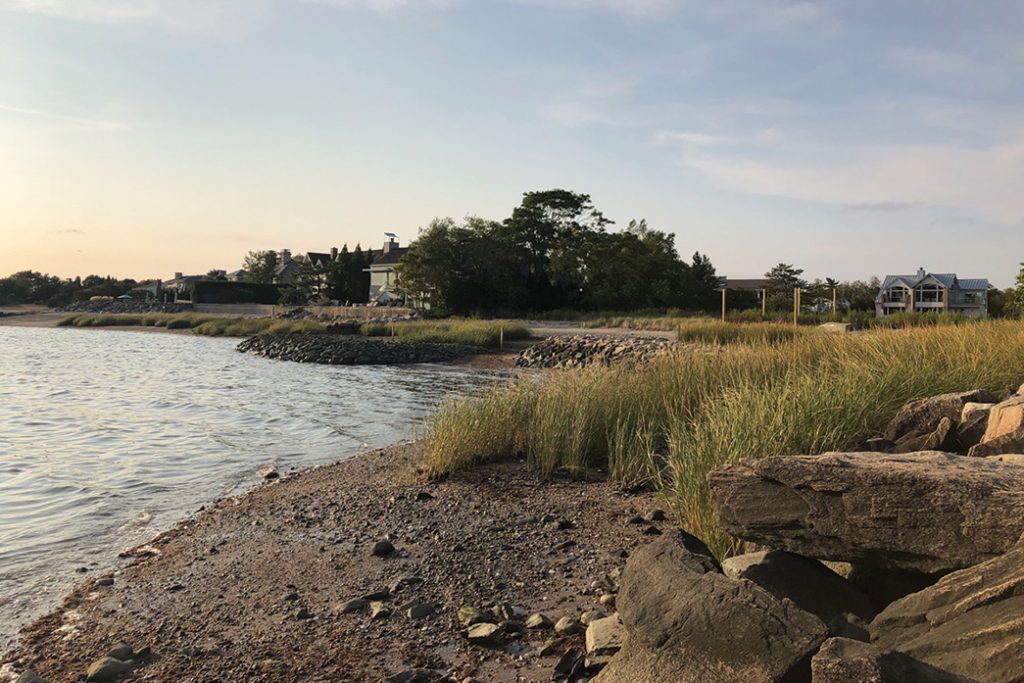
After – “Hybrid” Marsh Sill Living Shoreline Solution
Following Hurricane Irene and Superstorm Sandy, the historic “hard” structures that protected the dwelling were damaged and in need of maintenance. Since the barrier beach adjacent to the structures naturally supports marsh vegetation, it was recommended by State and Federal regulators to design a living shoreline to increase marsh vegetation. With the owner in agreement, RACE consulted and provided regulatory permitting services for a “hybrid” living shoreline solution consisting of a series of two marsh sills placed along the waterfront. A marsh sill is a low-lying rock structure that is placed within the tidal column and holds sediment and marsh vegetation landward of its position. The marsh sill is designed to dissipate incoming wave energy while still allowing the daily inflow of water into the marsh to support its ecosystem. The two marsh sills designed for the project site are comprised of rock and coir logs. Native marsh vegetation was planted, according to their appropriate elevations, landward of the rock sill.
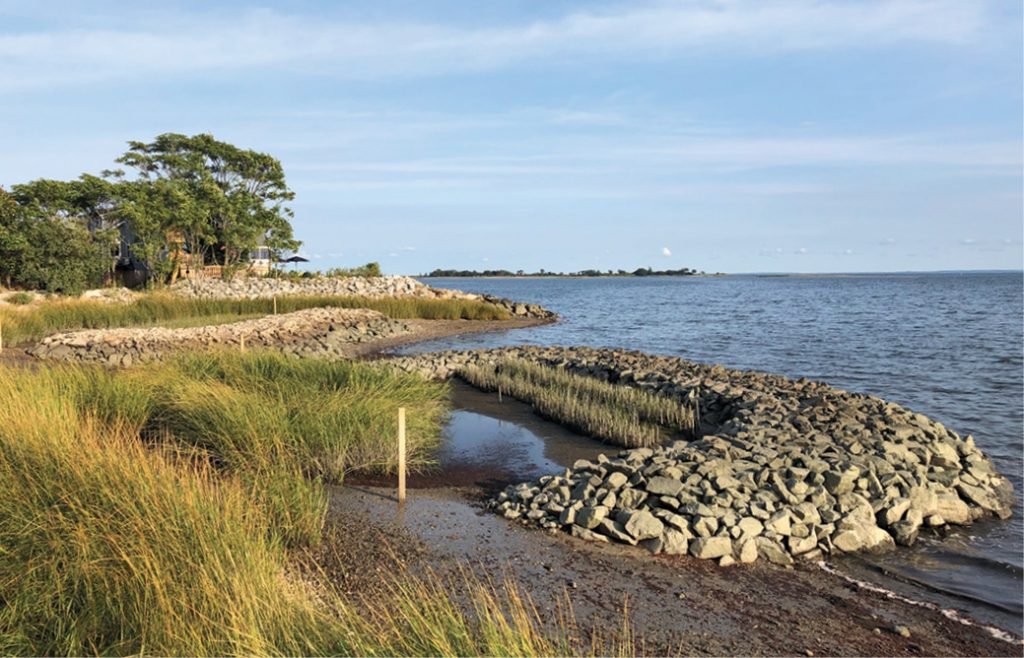
After – “Hybrid” Marsh Sill Living Shoreline Solution
Marsh sills should only be considered in locations that support their functionality. The design of a marsh sill must be tailored to the characteristics of the project site. Features such as the height and width of the sill, sediment elevation to support the marsh plantings and the rock size are dependent on the wave climate, the tidal range, etc. These “hybrid” living shoreline solutions provide the functionality of dissipating wave energy before it impacts the project site while also supporting a marsh ecosystem.
Living shorelines are starting to become the “go-to” solution of regulators, engineers and designers since they naturally provide resiliency and sustainability at a project site. The design of living shorelines range based on the location in which they are being placed. “Green” solutions are recommended for areas with a low wave energy climate whereas “hybrid” solutions may be constructed in locations with a moderate to high wave energy climate. Since designing living shorelines solutions is a relatively new approach to addressing resiliency, innovation, monitoring, and adaptive maintenance are key to designing and constructing a long-lasting, sustainable solution. ■
Hailey Simpson earned her Master of Oceanography – Coastal Systems degree at the University of Rhode Island, and joined the Professional Team at RACE Coastal Engineering in 2017. Her work includes performing wave transformation analysis, wave load calculations on coastal structures, and coastal flood mapping studies along the Connecticut, New York and Massachusetts coastlines. Celebrating 20 years of service to the waterfront community, RACE’s mission is “to enhance quality of life, experience, property & infrastructure by providing responsive solutions where water meets land.” To learn more, log onto racecoastal.com.



